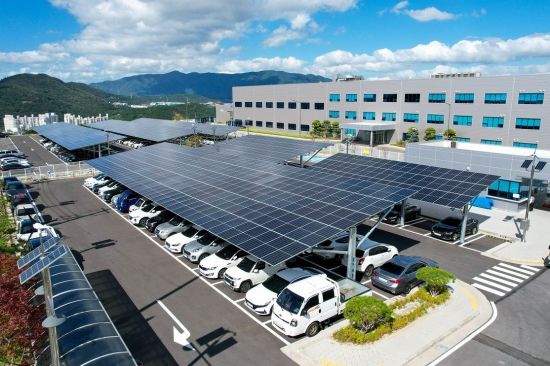
In the push toward renewable energy, one of the biggest debates revolves around land use. Solar farms often require vast tracts of arable land, potentially competing with agriculture and disrupting ecosystems. But what if we could harness solar power without sacrificing farmland? Enter the innovative approach of installing solar panels over parking lots—a solution that utilizes existing urban infrastructure, provides shade for vehicles, and generates clean energy. South Korea is leading the way with a new mandate that prioritizes parking lots for solar installations, offering a model that could inspire global adoption.
The United States should not mandate that every parking lot be covered in solar panels, but rather incentivize and look at putting in bigger roadblocks to putting solar farms up on farmland.
Robert Bryce’s short Documentary “SUNBLOCK: The global fight to save farmaland from big solar” is a great video and highlights the main pain points of the blight of solar panels on farmland.
Robert has been on the Energy News Beat Podcast several times, and he is a great resource for the American Energy Markets. Follow all of his work on Robertbryce.com
South Korea’s Energy Landscape: A Heavy Reliance on Fossils and Nuclear
South Korea, as one of the world’s top energy consumers, faces significant challenges in transitioning to renewables. In 2024, the country’s electricity generation mix was dominated by coal at 33% and nuclear at 31%, with natural gas contributing around 27%. Renewables accounted for about 10%, primarily from solar and wind, marking the first time this share reached double digits.
ieefa.org
Total electricity generation stood at approximately 600 TWh, while consumption hovered around 558 TWh in recent years, with per capita usage at about 11,251 kWh in 2025.
This mix reflects South Korea’s industrial economy, where over 80% of energy comes from fossil fuels, making it the seventh-largest energy-consuming nation globally.
With electricity demand projected to grow by 30% by 2035, the government is under pressure to boost low-carbon sources, which made up 40% of generation in 2024—aligning with global averages but lagging behind leaders in renewables.
Solar power has seen rapid growth, with additions surpassing 3.1 GW in 2024 alone, but the country still imports most of its energy, highlighting the need for domestic renewable expansion without encroaching on limited farmland.
The Mandate: Turning Parking Lots into Solar Powerhouses
On August 13, 2024, South Korea’s Ministry of Trade, Industry, and Energy announced amendments to the Enforcement Decree of the Act on the Promotion of the Development, Use, and Diffusion of New and Renewable Energy. This policy mandates the installation of solar power facilities, such as canopy-type panels, in public parking lots with an area of 1,000 square meters or more—equivalent to about 80 standard parking spaces.
The rule applies retroactively to both new and existing facilities operated by central or local governments and public institutions, excluding underground, mechanical, or truck parking areas where installations are impractical.
Implementation began at the end of November 2024, following a public consultation period that ended in September.
Owners have flexibility: they can install the panels themselves or lease the space to external operators who handle the setup and operations.
The government supports this through preferential financing and incentives to encourage adoption.
The policy targets approximately 2,995 public parking lots nationwide, aiming to maximize idle urban space for renewable energy while avoiding the need for new land development.
This approach aligns with South Korea’s broader goal of energy transition, positioning the public sector as a leader in eco-friendly initiatives.
Costs vs. Benefits: A Win for Efficiency and Sustainability
While specific cost estimates for the nationwide rollout aren’t publicly detailed, general insights into solar installations in South Korea provide a framework. The levelized cost of electricity (LCOE) for onsite solar PV ranges from $0.11 to $0.14 per kWh, making it competitive with traditional sources.
Solar carports, which involve elevated structures, typically cost more upfront than ground-mounted systems—around $2-4 per watt installed globally, potentially higher in urban settings due to engineering needs. For South Korea, government subsidies and leasing models could offset much of this, with owners avoiding direct expenses by partnering with operators.
On the benefits side, the advantages are multifaceted:
Energy Generation: Parking lot solar canopies can produce 300-500 watts per square meter, depending on location and technology.
With 2,995 lots affected, assuming an average of 100 spaces per lot and a conservative capacity of 200-300 kW per lot (based on typical carport designs), the total added capacity could exceed 600-900 MW. At South Korea’s solar capacity factor of about 15%, this might generate 0.8-1.2 TWh annually—enough to power hundreds of thousands of homes and contribute meaningfully to the 10% renewable share.
Environmental Gains: By reducing reliance on coal and gas, the installations could offset significant emissions, similar to removing 185,000 vehicles from the road per large project, as seen in comparable U.S. examples.
It also mitigates urban heat islands, as shaded lots lower ambient temperatures and prevent asphalt from absorbing and radiating heat.
Economic and Practical Perks: Owners gain revenue from energy sales or leasing, while users benefit from shaded parking that protects vehicles from sun, rain, and snow—extending battery life in EVs and reducing air conditioning needs.
The policy creates jobs in solar installation and maintenance, boosting the local economy. Additionally, canopies can integrate EV charging stations, supporting South Korea’s growing electric vehicle market.
Compared to farmland solar, parking lot installations avoid soil disruption, preserve agricultural output, and repurpose underutilized space. While initial costs may total billions, long-term savings from reduced energy imports and emissions could yield a positive return within 5-10 years, especially with falling solar prices.
Why This Matters Beyond South Korea
South Korea’s mandate showcases a pragmatic path to renewables: leverage existing infrastructure to accelerate clean energy without trade-offs. As countries grapple with land constraints, this model could scale globally—imagine U.S. states like California or Texas mandating solar over mall lots or airports. By choosing parking lots over farmland, we’re not just generating power; we’re building a more resilient, efficient future.
For more on energy innovations, stay tuned to Energy News Beat Channel.
Got Questions on investing in oil and gas? Or do you have a Tax Burden in 2025?
ENB Top News
ENB
Energy Dashboard
ENB Podcast
ENB Substack







